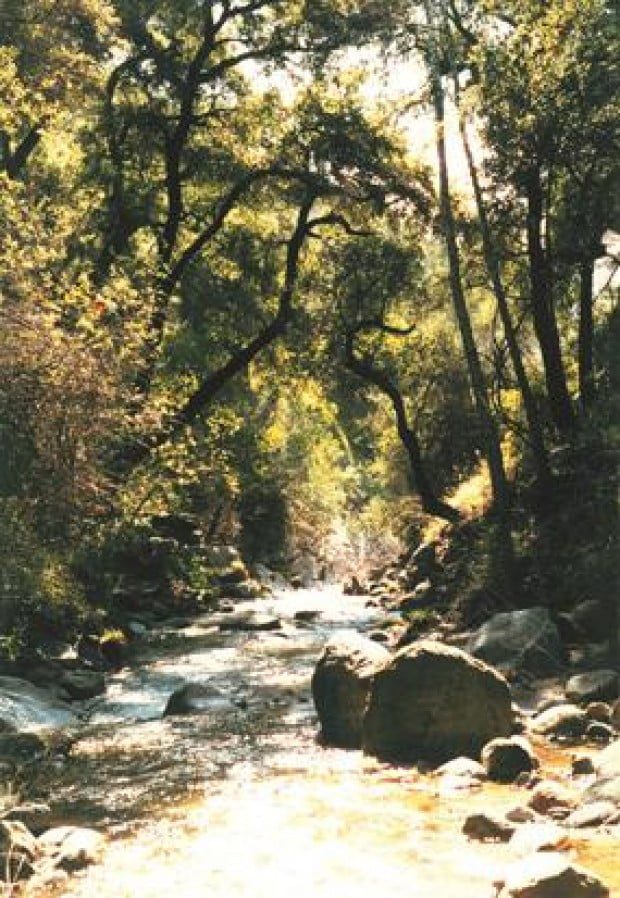
Entering its 26th year, the nonprofit Mountains Restoration Trust expands its mandate from protection to restoration, preservation and education.
By Vicky Shere / Special to the Malibu Times
A small bridge at the junction of Mulholland Highway and Old Topanga Canyon Road brings you to the 1950s, energy-efficient home that is the headquarters of the Mountains Restoration Trust.
Located in the 12-acre Headwaters Corner Interpretive Center at Dry Canyon Creek in Calabasas, the site is both a mirror of MRT as a link between land protection groups and a testament to its role as steward of major swaths of environmentally sensitive areas in the Santa Monica Mountains.
Nearly 26 years after its first board meeting, MRT’s habitat restoration at the site will be an event of the California Coastal Commission’s 23rd annual Coastal Clean Up Day this Saturday.
“The Mountains Restoration Trust has performed an incredibly valuable public service,” Peter Douglas, executive director of the California Coastal Commission, said. “Preserving precious resources in the mountains would not have happened without them.”
Today, the MRT is the largest nongovernmental landowner in the Santa Monica Mountains, owning more than 1,500 acres.
MRT’s unique status as a land trust (a nonprofit for the protection of real property) differentiates it from regional public agencies, says Stephen Harris, MRT’s executive director.
The trust can offer a tax deduction to the landowner for the difference between a property’s fair market value and what the MRT can pay, Harris, a former real estate developer, added. The MRT can act quickly to secure property by exercising its ability to option land and borrow funds. And, as a 501(c)(3) nonprofit organization, the MRT can receive tax-deductible contributions.
Locally, MRT’s multifaceted success is apparent in the Malibu Riding and Tennis Club (which it acquired and transferred to the Nature Trust of the Santa Monica Mountains), the Cold Creek Preserve (which it owns), Trancas Canyon Park (which it helped the City of Malibu acquire) and Tuna Canyon (nearly 90 percent of 417 acres were donated to the MRT by John Paul DeJoria, founder and president of Paul Mitchell Hair Care Systems.)
Malibu resident and city grant writer Barbara Cameron credits Harris for helping the city acquire its 13-acre Trancas Canyon Park for only $120,000.
Harris, who serves on land-use committees with Cameron, heard the investment group that owned the property had decided not to develop it and suggested the city acquire it for the remainder of the transfer development fee the owner had not paid.
“The MRT is a great partner for park agencies, cities and counties in achieving their restoration and preservation goals,” Cameron says.
Collaborative achievements
The Mountains Restoration Trust was formed in 1981 as a partnership between the California Coastal Commission and California Coastal Conservancy to mitigate residential over-development in the Santa Monica Mountains through the transfer development credit program.
The MRT was also created to preserve the land in the Cold Creek watershed and to maintain the pristine quality of Cold Creek, which feeds into Malibu Creek, said Peter Ireland, MRT’s former executive director and now president of the Nature Trust of the Santa Monica Mountains.
Over the years, the MRT role has evolved from acquisition to preservation, restoration, education and access.
In 1983, the MRT acquired 150 acres of small lots in Las Flores Canyon, which eventually were transferred to the Santa Monica Mountains Conservancy.
MRT’s role expanded in 1984, when it was asked by The Nature Conservancy to accept the 520-acre Murphy Ranch Preserve, now known as Cold Creek Preserve. By now, MRT has acquired all but 15 acres of the watershed.
“As we acquired property, we realized we needed to restore its sustainability and use it for recreational purposes,” Harris said.
The Santa Monica Mountains Trails Council helped the MRT complete the Stunt High Trail. MRT and California State Parks initiated the Commemorative Oaks program in Malibu Creek State Park in 1992. Through partnerships with Cold Creek docents, the University of California Natural Reserve System, the National Park Service and California State Parks, the MRT has brought thousands of people into the Santa Monica Mountains.
Within the last few years, the MRT has expanded its role into education through its “On the Edge” program for people living in the urban/rural interface.
With funding from the Southern California Wetlands Recovery Project and the California Coastal Conservancy, MRT published a brochure on reducing human/wildlife conflict and increasing public understanding of the value of wildlife and habitat.
“People move to the mountains because of its beauty,” Harris said. “We want the community to recognize the role they play in stewardship.”
Another role for MRT is coordinating private funding and community support, as it did with the multiagency acquisition of the 588-acre King Gillete Ranch (previously owned by Soka University) in 2005, an achievement hailed by Santa Monica Mountains Conservancy executive director Joe Edmiston.
“Land preservation, especially in the most sophisticated real estate market in the world, requires not only staying power and a united front, but also the ability to respond swiftly and precisely to the demands of any given opportunity,” Edmiston said. “When we finally had a willing seller, the trust stepped up and raised critical private funds that demonstrated local support to state funders. Time and again, the trust has come through with what is needed at the key moment.”
More information and reservations for restoration projects can be obtained by calling 818.591.1701, or online at www. mountainstrust.org